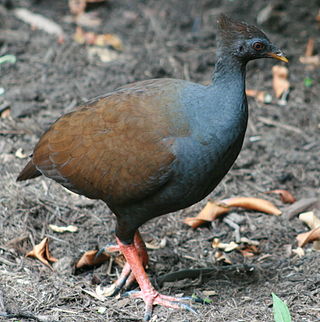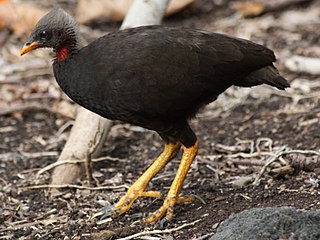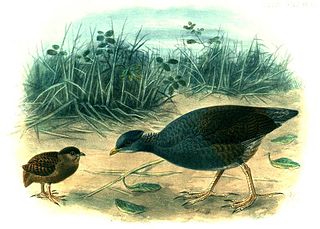
The megapodes, also known as incubator birds or mound-builders, are stocky, medium-large, chicken-like birds with small heads and large feet in the family Megapodiidae. Their name literally means "large foot" and is a reference to the heavy legs and feet typical of these terrestrial birds. All are browsers, and all except the malleefowl occupy wooded habitats. Most are brown or black in color. Megapodes are superprecocial, hatching from their eggs in the most mature condition of any bird. They hatch with open eyes, bodily coordination and strength, full wing feathers, and downy body feathers, and are able to run, pursue prey and, in some species, fly on the day they hatch.

The Nicobar megapode or Nicobar scrubfowl is a megapode found in some of the Nicobar Islands (India). Like other megapode relatives, it builds a large mound nest with soil and vegetation, with the eggs hatched by the heat produced by decomposition. Newly hatched chicks climb out of the loose soil of the mound and being fully feathered are capable of flight. The Nicobar Islands are on the edge of the distribution of megapodes, well separated from the nearest ranges of other megapode species. Being restricted to small islands and threatened by hunting, the species is vulnerable to extinction. The 2004 tsunami is believed to have wiped out populations on some islands and reduced populations on several others.

The dusky megapode, also known as dusky scrubfowl or common megapode, is a medium-sized, approximately 41 cm long, blackish bird with a short pointed crest, bare red facial skin, dark legs, brown irises, and a dark brown and yellow bill. The male and female are similar. This terrestrial species lives in forests and swamps, including mangroves, of the Maluku and Raja Ampat Islands in Indonesia. Like other megapodes, it lays its eggs in a mound made from earth mixed with leaves, sand, gravel, and sticks, which can be as large as 11 m (36 ft) in diameter and stand nearly 5 m (16 ft) tall.

The orange-footed scrubfowl, also known as orange-footed megapode or just scrubfowl, is a small megapode of the family Megapodiidae native to many islands in the Lesser Sunda Islands as well as southern New Guinea and northern Australia.

The Micronesian megapode or Micronesian scrubfowl is an endangered megapode which inhabits islands of the Western Pacific Ocean.

The Moluccan megapode, also known as Wallace's scrubfowl, Moluccan scrubfowl or painted megapode, is a small, approximately 31 cm long, olive-brown megapode. The genus Eulipoa is monotypic, but the Moluccan megapode is sometimes placed in Megapodius instead. Both sexes are similar with an olive-brown plumage, bluish-grey below, white undertail coverts, brown iris, bare pink facial skin, bluish-yellow bill and dark olive legs. There are light grey stripes on reddish-maroon feathers on its back. The young has brownish plumage, a black bill, legs and hazel iris.
The New Guinea scrubfowl or New Guinea megapode is a species of bird in the family Megapodiidae. It is found in New Guinea, mostly in the northern half. Its natural habitats are subtropical or tropical moist lowland forest and subtropical or tropical moist montane forest. This species was formerly known as Megapodius affinis but Roselaar, 1994 showed that Megapodius affinis A. B. Meyer, 1874 refers to M. reinwardt.

The Sula megapode or Sula scrubfowl is a species of bird in the family Megapodiidae. It is found only in the Banggai and Sula Islands between Sulawesi and the Maluku Islands in Indonesia, where its habitats are subtropical or tropical dry forest, subtropical or tropical moist lowland forest, subtropical or tropical mangrove forest, and subtropical or tropical moist shrubland. It is threatened by habitat destruction.

The Philippine megapode, also known as the Philippine scrubfowl or the Tabon scrubfowl, is a species of bird in the family Megapodiidae. It is found in the Philippines, northeastern Borneo, and Sulawesi. It has a wide range of natural habitats which include tropical dry forest, tropical moist lowland forest, tropical moist montane forest and small islands. The species was named after the collector Hugh Cuming.

The Melanesian scrubfowl or Melanesian megapode is a megapode species that is endemic to islands within Melanesia. The Melanesian scrubfowl has a unique strategy of egg incubation in which it relies on environmental heat sources. This bird species is culturally important for Indigenous peoples in Melanesia.

The Biak scrubfowl or Biak megapode is a species of bird in the family Megapodiidae. It is found only on the islands of Biak, Mios Korwar, Numfor, Manim and Mios Num in the West Papua region of Indonesia.

The Vanuatu megapode or Vanuatu scrubfowl is a species of bird in the family Megapodiidae. It was formerly known as the New Hebrides scrubfowl. It is found only in Vanuatu. Its natural habitat is subtropical or tropical moist lowland forest. The species is threatened by habitat loss and egg collecting.

The Tongan megapode is a species of bird in the megapode family, Megapodiidae, currently endemic to Tonga. The species is also known as the Polynesian megapode, and as the Niuafo'ou megapode after the island of Niuafo'ou to which it was restricted for many years. The specific epithet honours British consul William Thomas Pritchard.

The barred rail is a species of rail found across the Philippines, Sulawesi (Indonesia) and Salawati. The species is common, but shy and difficult to see.

The scrubfowl are the genus Megapodius of the mound-builders, stocky, medium-large chicken-like birds with small heads and large feet in the family Megapodiidae. They are found from south-east Asia to north Australia and islands in the west Pacific.

Moyo is an island off the north coast of Sumbawa Island, in Sumbawa Regency, West Nusa Tenggara province, Indonesia.
The pile-builder megapode is an extinct species of megapode. The subfossil remains were found by Jean-Christophe Balouet and Storrs L. Olson in the Pindai Caves of New Caledonia. Its remains have also been found on Tonga.

The Banda Sea Islands moist deciduous forests is a tropical moist forest ecoregion in Indonesia. The ecoregion includes several island groups in the southwestern Banda Sea, including the Tanimbar Islands, Kai Islands, and the Barat Daya Islands except for Wetar.
The Viti Levu scrubfowl, also known as the Fiji scrubfowl or lost megapode, is an extinct megapode that was endemic to Fiji. The epithet amissus, from Latin "lost", refers to its extinction. Subfossil remains were collected from the Udit cave at Wainibuku on the island of Viti Levu in October 1998 by Trevor Worthy, G. Udy and S. Mataraba, and described by Worthy in 2000. The holotype is held by the Museum of New Zealand.
The consumed scrubfowl is an extinct megapode that was native to Fiji and Tonga in the south-west Pacific Ocean. It was originally described from subfossil remains collected by David Steadman from an archaeological site at Tongoleleka, on the island of Lifuka in the Haʻapai group of the Kingdom of Tonga. The specific epithet and vernacular name refer to its evident use as a food item. Subsequently, remains were also found on Lakeba and Mago in the Lau group of Fiji by Trevor Worthy. It likely became extinct through overhunting following human settlement of the islands some 3,500 years ago but may have persisted until the mid-late 19th century.

















